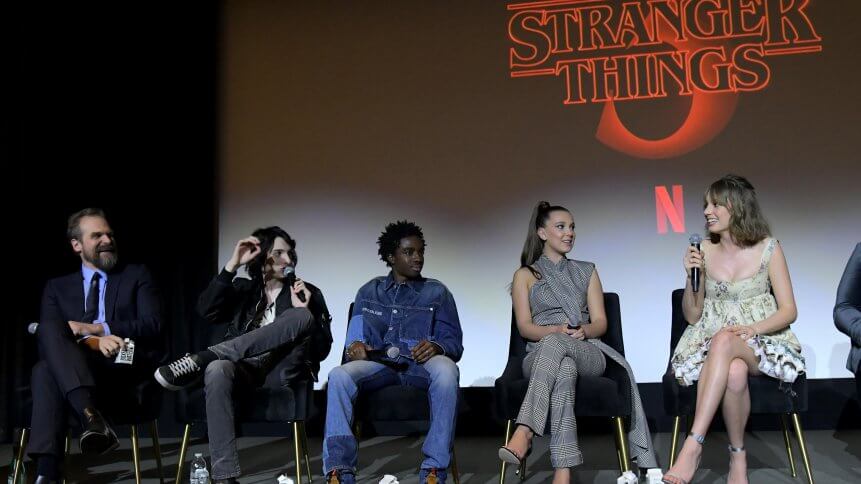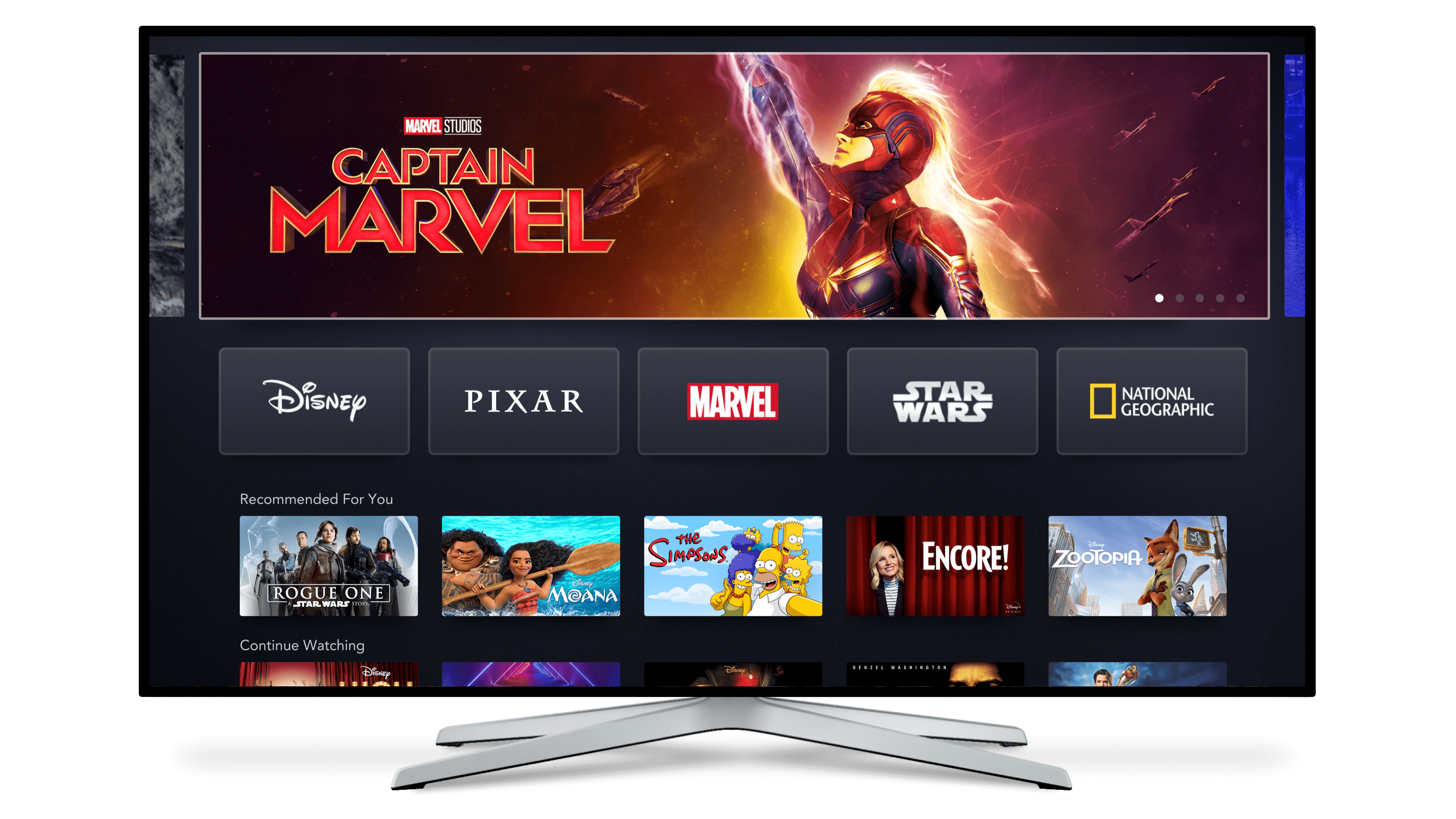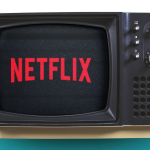The Streaming Wars – where tech matters as much as content

With Apple TV+, Disney+, HBO Max, Peacock, and Quibi joining the entertainment industry’s OTT reconfiguration, there’s a lot of focus on creative content… but CTOs also have a huge role to play. And the stakes are high.
Market research indicates that global OTT media revenue could more than double by 2024. Media companies are expanding their operations, revising their strategies, and suddenly appearing on the scene with massive venture capital, all in an effort to capture some of this dramatic growth.
Apple’s iPhones are still lucrative and they account for a little over half of the company’s total revenue, but that category is declining year-over-year. It’s no wonder then that Apple looked over at Netflix and thought: we can do that, too. The tech giant spent US$6 billion on its initial lineup of content, which expanded from an original US$1 billion content budget. Streaming services want to attract subscribers with compelling originals. But Apple’s experience on the tech side is also extremely relevant.
Here are 11 technical factors that could turn out to be significant.
# 1 | Patent enforcement remains critical
When the entertainment industry talks about “IP,” it’s often shorthand for stories, characters, and comic book-spawned universes. That wasn’t the case recently.
Quibi, a new streaming service focused entirely on short-form, mobile content, raised US$1.75 billion. Then, less than a month away from its launch, Quibi became engaged in a legal battle in the U.S. District Court for Central California. They’re trying to fend off patent infringement claims from Eko, an interactive video company, regarding their “Turnstyle” feature. Both companies hold patents.
Eko alleges that Quibi founder Jeffrey Katzenberg and people now associated with Quibi had met with them previously. Quibi responded that the employees referenced by Eko are not engineers or computer programmers and do not read source code. Quibi maintains that Turnstyle was developed internally.
Shortly after this legal fight began, semiconductor manufacturing company Broadcom filed its own patent infringement lawsuit against Netflix.
# 2 | Feature experimentation is always essential
The established streaming services also understand the importance of unique features. To that end, they’re continually experimenting, even though some of those experiments don’t work out.
In its Q4 2019 letter to shareholders, Netflix disclosed that they conducted hundreds of product tests throughout the year. These tests attempted to improve subscribers’ experiences with sign-up, payments, and content discovery.
“About 30 percent of these led to a gain in retention, engagement or revenue, up from 20 percent in the prior year,” the letter noted. “It’s a humbling exercise as so many of our ideas do not ‘win’ with members, but this helps tune our judgment and innovation priorities for the future.”
The Netflix film Black Mirror: Bandersnatch gave subscribers an interactive narrative. To make the nonlinear, choice-driven storytelling flow, the platform had to pre-cache the possible subsequent scenes. However, this interactive content wasn’t made available on Chromecasts, Apple TVs, and other devices due to technical incompatibilities, which frustrated some subscribers.

Black Mirror writer Charlie Brooker collects an Emmy for Bandersnatch. Source: AFP
# 3 | High-resolution content generates demand for high-performance storage
Gen Z viewers are voracious consumers of digital video on mobile and when it comes to social media content, they seem to value authenticity more than high production values. At the same time, Hollywood productions aimed at global distribution seem to be integrating even more cutting-edge visual effects. Those immersive experiences depend on a highly optimized technological foundation. Massive storage, bandwidth, and computational power is required during post-production.
Regardless of where the content ends up streaming, it can’t be created in the first place without the right tech.
According to Quantum, a tech company with Hollywood clients, storage infrastructure must be equipped to handle higher-resolution media, higher shooting ratios, different content formats, global collaboration, and intensive visual effects rendering. Quantum’s storage servers can provide nearly 10GB/s single client streaming performance at less than 16ms, which is enough performance to not drop frames when real-time editing 8K 60FPS content.
# 4 | Limited broadband access is a temporary barrier
Content creators are making big investments during pre-production, production, and post-production in order to ensure the quality of their product. But some of that quality is being degraded during delivery. Although broadband and 5G offer faster speeds, the United States has been moving slowly on deployments and expansions.
I asked James Henry, the CTO of PureWeb, if this inadequate infrastructure will hold new entertainment technologies back. PureWeb offers interactive streaming solutions for real-time 3D visualizations and simulations. They have medical and industrial clients.
“So we were addressing some of the things you’re talking about, which is where you’ve only got 4G or a bad wireless connection,” said Henry.
“How do we send valuable information [to clients]? And the way you do that is if you’ve taken a one gigabyte file of some body part or a car model, we just take a frame and send that. So it’s just like a movie, you send a bunch of frames, but you don’t have to wait for a one to ten gigabyte download and then overwhelm the storage and compute.”
New technologies like AR and VR require additional layers of interactivity that go far beyond the limited choices in Netflix’s Bandersnatch.
“And we’ve gotten pretty good at that but the hardest thing that we can’t overcome actually is less the network problems than distance,” said Henry. “The speed of light is the speed of light. And if you’re too far away, it’s just going to get choppy and difficult to watch.”
To that end, new edge computing paradigms and mobile technologies are being actively considered.
# 5 | Traffic surges illustrate the need for scalability
Disney+ had a series of outages on the day that it debuted. Kevin Mayer, head of Disney’s direct-to-consumer division, indicated that the app’s architecture was at fault.
In 2017, the Walt Disney Company acquired majority ownership of BAMTech, a streaming technology company that started out in sports. BAMTech tested 8K streams back in 2015. Despite this tech advantage, Disney’s platform apparently couldn’t handle the demand of the 10 million initial subscribers. Other Disney+ glitches were attributed to coding issues.
According to Jeremy Legg, the CTO of Warner Media, stumbles tend to happen whenever a company is building scaled technology. Scalability introduces problems not just with streaming but also with authentication systems, entitlement systems, and billing systems.
“And you’ve got to run through a pretty robust set of use cases, both in terms of humans banging on this and testing it, but also automated scripting and automated testing to do load balancing across all of these different areas,” he said in a Variety podcast interview.
# 6 | Chaos engineering makes things work better
Rigorous testing, like the kind that Jeremy Legg describes, is in the interests of all tech companies. The most extreme version of this is “chaos engineering,” and it actually originated at Netflix. Netflix created a whole suite of programs to deliberately break things. It makes their IT teams more aware of vulnerabilities. It establishes a sense of stakes. Sometimes, the self-inflicted damage actually impacts real users but it ultimately makes the service perform better.
This somewhat radical approach began with a program called “Chaos Monkey,” which randomly disables a server during its usual hours of activity.
Netflix’s senior software engineering lead Ali Basiri told TechHQ that systems are becoming increasingly complex and it’s hard to predict how they will behave under different circumstances. To avert chaos, you have to anticipate it and, sometimes, inflict it in a controlled way.
YOU MIGHT LIKE

Do virtual conferences make more sense today?
# 7 | Live broadcast technology makes sports content possible
Some people in the entertainment industry have floated the idea that Netflix should get involved in sports.
George Lopez, the Senior Vice President of Operations at The Switch, specializes in the live TV broadcasting business. “I think they’re going to absolutely jump into sports,” he told me. “I mean, Amazon’s already there. YouTube is already there.”
Of course, this, too, will present technical challenges. When I asked Lopez which proprietary or distinguishing technologies would give his company a competitive advantage in this new media landscape, he cited The Switch’s low latency, robust network and its control room in Burbank.
By calling back the OB trucks, keeping production staff in a central production facility, and deploying only the essential camera operators and crew, live broadcasters could reduce costs by 40 percent or more.
Lopez explained, “Transporting signals over dark fibre or via IP circuits with high security and relatively low latency is now possible and has redundancy built in to eliminate disruption.”
# 8 | UX/UI is a form of branding
Deliberate UX/UI design will help streaming services to deliver a smooth experience and clear interface.
Some consumers already feel paralyzed by excessive choice and they want the platform to draw them in without any clunkiness or confusion. According to Jeremy Legg, the status quo looks like “endless scrolls of tiles,” largely driven by an algorithm. Within the HBO Max interface, he’s trying to create sections where real people do the curation, publishing, and merchandising.
Media companies are also leveraging and amplifying their brands through carefully-crafted UI. For example, in the Disney+ interface, “Disney,” “Pixar,” “Marvel,” “Star Wars,” and “National Geographic” appear as clickable buttons in a prominent, horizontal bar. All of these brands represented expensive acquisitions and now they’re a method of library exploration.

The Disney+ layout entices users to explore its range of content. Source: Disney+
Frank Patterson, the CEO of Pinewood Atlanta Studios, told me that executives at media companies need to make sure that their brands continue to stand tall and have meaning as we enter into this new age.
Patterson is very familiar with prominent media brands and storytellers. Elaborate sets have been built and creatively destroyed at Pinewood Atlanta’s sound stages and backlots for a variety of productions, including Marvel’s “Avengers: Endgame” and “Avengers: Infinity War.”
“We knew there was going to be this acquisition and consolidation kind of tendency in the marketplace,” said Patterson. “It was important for these different studios to deepen their libraries.”
Patterson said that as a consumer, he thinks of the Disney brand broadly — “to me, it’s the best storytelling brand in the world.”
# 9 | Gen Z wants mobile-friendly storytelling
Quibi is betting big on the idea that short-form, mobile content will match demographic trends. So is Benoit Vatere, Founder and CEO at Mammoth Media, a Santa Monica-based company that is making original short-form content in interactive formats.
Vatere said that for a long time, and still today, “the best way to get your kind of shot of dopamine through content was to open a social platform and go through the feed.” But he says that users are increasingly unsatisfied by this and they’re looking for other forms of mobile entertainment.
“When you look at how much time people are going to spend on a very specific piece of content, it’s anywhere between two and three minutes,” he said. “And why is it two or three minutes? There’s a lot of different reasons. But it’s basically the level of interaction that you get on the phone — again, for the audience that we’re working with, which is Gen Z. And the interaction can come from people talking to you, it can come from push notifications that are popping up on your screen. There’s a lot of different things that will get you out of the content that you’re currently consuming.”
Smartphones serve up endless chimes, vibrations, and on-screen notifications. But mobile-first could be the future and it requires strategic adaptation.
# 10 | In a globalized, tech-infused industry, roles constantly change and expand
Hollywood and Silicon Valley are merging. As this happens, roles are evolving and the industry is becoming more globalized.
Carolyn Hunt, a partner in the Entertainment, Media and Sports Practice Group in Barnes & Thornburg’s Los Angeles office, said that her job is more exciting now.
“I’ve been working for a very long time in the finance and distribution stage of film and TV,” she said. “And for a long time, the most common deals that would come across my desk would be bank finance deals.”
In the early days of streaming, things stayed the same. Netflix would enter into distribution deals with content providers and financiers would lend against the receivables coming in from distribution — business as usual. But then Netflix got more cash, big tech joined the streaming wars, and the demand for content increased.
“Amazon has a lot of its own money, Apple has a lot of its own money,” said Hunt. “And so they’re able to more or less act like a studio and sort of self-finance these. The typical financing model has really changed a lot. So my practice has changed in that I actually represent a lot of producers now, because there’s just less third-party financing needed on a lot of these types of streaming deals.”
Technology introduced rapid, significant changes throughout the entertainment industry and people are trying to keep up.
“I’m kind of turning into a legal/business advisor based on these changes just because everything’s changing so fast,” she told me. “Our clients are looking to us to help them sort of navigate the business waters as much as they are asking us to help document deals that they’ve already cemented.”
For Thomas Lucas, the co-founder of a documentary streaming service called MagellanTV, the new streaming environment was a way to gain greater autonomy.

Multi-device streaming services. Source: MagellanTV
Lucas has written, directed, and produced many TV documentaries about science and space. When I asked him about a recent controversy pertaining to series financing, he replied, “We made a deliberate decision to leave that world behind. So, we never wanted to have to bargain for our contracts and suffer a loss if production costs went over. And also to endure the squeeze of network contracts, especially the cable ones. So we left that behind in an attempt to forge an independent path. And, you know, control our own world, you might say.”
Across the entire streaming ecosystem, it’s clear that jobs are being redefined. Skilled tech workers are in high demand across sectors but streaming services may be able to recruit them by emphasizing some of this flexibility and change, along with the creative nature of the product. If you’re a product designer who’s obsessed with Game of Thrones, the workplace at HBO Max might have more of a lure than a redundant B2B SaaS play.
# 11 | Data shouldn’t always influence creativity
Streaming services are also collecting robust viewership data, though they have been reluctant to release their ratings publicly. These integrated analytics inform their marketing and monetization strategies, as well as their future creative and investment decisions. But this process leaves room for error. Intuition and relationships still matter.
All of this underlying technology isn’t discussed as often as the streamable content, but it could determine which streaming services succeed and which ones fail. By taking a closer look “under the hood” of streaming tech, investors and executives will have a better sense of media companies’ trajectories and risk factors.








